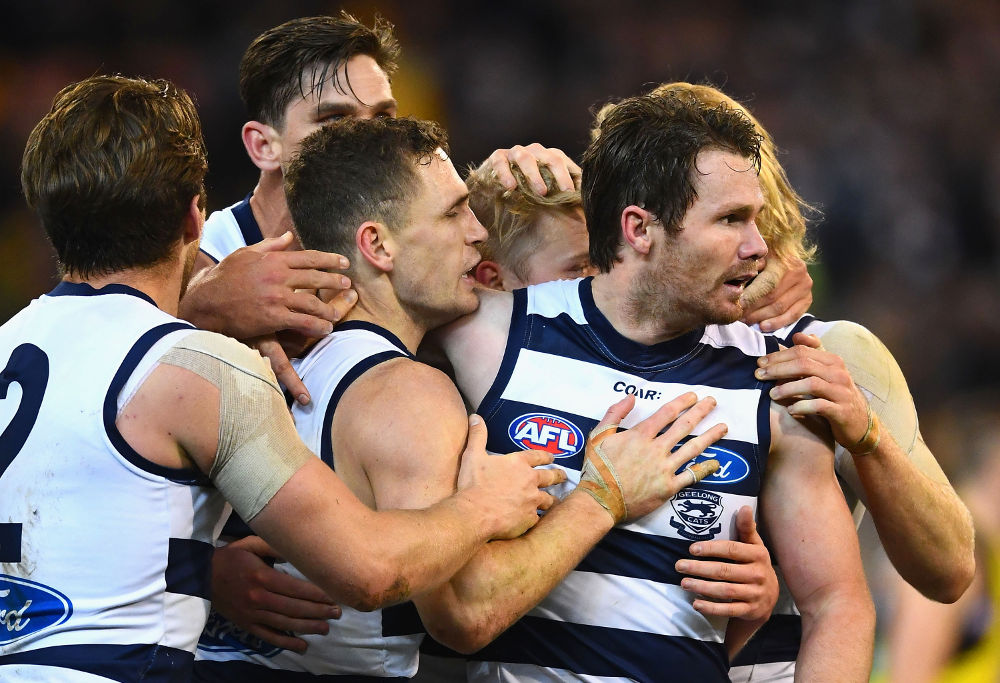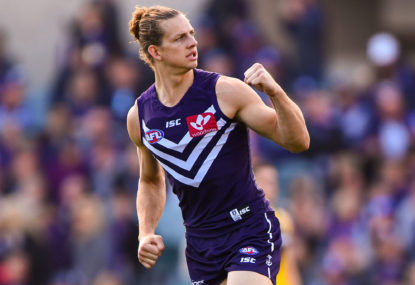If you’ve watched any of the AFL’s preseason matches, or followed the coverage in the usual mainstream outlets, you’ve probably noticed one of this year’s hot topics: playing gun midfielders as forwards.
It’s not radical; the idea of Gary Ablett Jr spending the twilight years of his career as a forward has been discussed for at least as long as Ablett has been in his 30s.
Port star Robbie Gray – about the closest thing we’ve seen to Ablett this decade – has been able to smoothly transition back and forth between midfield and forward, earning All-Australian honours as both an inside-50 star and an onballer.
What makes it different this time around is the players being discussed or, to be more specific, the size and shape of the players being discussed. The four names most regularly thrown around are Marcus Bontempelli, Patrick Cripps, Patrick Dangerfield and Nat Fyfe.
Dangerfield, listed at 189cm and 92kg, is the shortest of the bunch, though no less powerful than 195cm, 93kg Cripps. All four of them would probably have been key forwards in an earlier era, an era in which many of today’s ‘expert’ commentators played.
It’s easy to imagine any one of them leading out of or wrestling in the goal square during the 1980s or ’90s. There’s also varying degrees of evidence that each could be effective as a stay-at-home forward.
What is rarely discussed, however, is the downside to such a move.
Perhaps the flash point for the entire discussion was Round 17 last season, when a hobbled Dangerfield was sent forward early in a game against the Hawks and booted five goals and six behinds in a best-on-ground performance.
It was an exceptional display from Dangerfield and his 11 scoring shots were bettered by only Lance Franklin’s 12 in rounds seven and 23.
But there was a price to pay. With Dangerfield as the go-to forward target, Tom Hawkins was a non-factor, going goalless for the only time in 2017, while the Cats got smashed in both the clearances (26-36) and inside-50s (46-55), which is not something you’d expect from them against the Hawks.
It’s also worth noting Hawthorn were without their three first-choice key defenders in James Frawley, Ben Stratton and Josh Gibson.
Dangerfield was again thrown forward with spectacular results in the Cats’ semi-final clash with the Swans, kicking four first-half goals and effectively ending the game by the major break.
Interestingly, Hawkins was again ineffective playing as a higher forward, finishing with 13 disposals, two inside-50s and one goal, which was the last of the game and came in the final minutes of a dreary fourth quarter.
There’s no question Dangerfield is an exceptional forward. In fact, according to Champion Data, “Dangerfield was both the best forward and the best midfielder in the AFL” in 2017.

Patrick Dangerfield has been a match winner in the centre square and the goal square. (Photo by Quinn Rooney/Getty Images)
It’s easy to say the Cats should use such a weapon in the forward half, but footy has never been more about territory and, in that sense, there might not be a more valuable player than the 2016 Brownlow medallist.
Playing mostly as a midfielder, Dangerfield booted 45 goals last season – the 11th most in the AFL. He finished the year three goals and two disposals short of becoming only the second player on record to average 30 disposals and two goals across a season – Bob Skilton did it in 1968.
He’s an incredible player who doesn’t need to be a permanent forward to impact the scoreboard.
The addition of Gary Ablett and the retirement of Tom Lonergan – which likely means a return to defence for Harry Taylor – only complicates things further for Geelong.
The question for Chris Scott is; does playing Dangerfield forward add to the Cats’ scoring power, or only Dangerfield’s?
I suspect it’s the latter but, from the outside at least, there is no clear answer.
Where the answer should be more obvious is at the Whitten Oval.
Marcus Bontempelli is by far the Bulldogs’ best player and most creative and damaging midfielder. His combination of size, poise, balance and awareness makes him one of the league’s best players.
But unlike Dangerfield – or Fyfe, for that matter – Bontempelli doesn’t have any traits that make him a particularly unique forward.
He’s not fast or explosively athletic and, while his 193cm and 93kg frame and clean hands are tough to deal with at stoppages, it’s nothing the league’s key defenders don’t deal with regularly.
There’s also the not insignificant matter of his finishing. Despite being a fine field kick, the Bont goes to water in front of the sticks. From 61 shots at goal in 2017, he booted only 20 goals.
Let him work his magic in the middle of the ground and leave the forward play to the forwards – they’ll be thankful to be on the end of Bontempelli’s work.
At Carlton, it seems like an equally obvious decision. While it’s fine to throw the monstrous Cripps forward for five or six minutes a quarter – especially if he can drag a smaller midfielder forward and create a mismatch – the Blues desperately need the clearance beast around the footy if they are to stay competitive.

The Blues need Patrick Cripps at the coalface. (Photo by Quinn Rooney/Getty Images)
With Bryce Gibbs now at Adelaide, Carlton’s midfield brigade consists of the very good Marc Murphy, Cripps and a collection of exciting, but unproven, kids and fringe AFL players.
It’s been hard enough for Brendon Bolton’s side to score in recent seasons, taking away their best ball-winner would only make it harder.
Finally there’s Fyfe. The 190cm Freo skipper is one of the game’s best aerialists. If the ball is in the air in his area – he’s a good chance to get his hands on it.
He’s also a magnetic player. If Fyfe is ahead of the ball, his teammates are probably going to kick it to him. That’s not great for the development of Cam McCarthy and Matt Taberner.
Let’s not forget what a force Fyfe is as an onballer. He was fourth in the league for contested possessions last season and top-10 for centre clearances in a low-scoring team.
No one cares more about the territory battle than Ross Lyon, which means we should expect Fyfe to do most of his work where the action is.
It’s fun to see the game’s best players impact the scoreboard directly, but it’s a mistake to think it’s a role that makes them more valuable.
Even in Port Adelaide, Gray’s shift forward also meant Chad Wingard took on more responsibility in the midfield. Balance matters.
Each situation is different, but when talking about midfielders moving forward it’s important to consider the consequences in every part of the ground, not just whether a star player might kick a few bags.
For Chris Scott and the Cats, it’s a difficult decision, but in most other cases it seems pretty straightforward.































































































